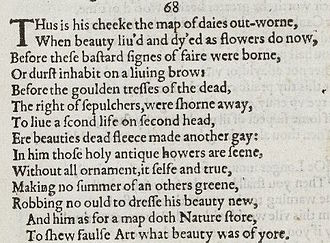Sonnet 68
| Sonnet 68 | |||||||
|---|---|---|---|---|---|---|---|
 Sonnet 68 in the 1609 Quarto | |||||||
| |||||||
Sonnet 68 is one of
Structure
Sonnet 68 is an English or Shakespearean sonnet. The English sonnet has three quatrains, followed by a final rhyming couplet. It follows the typical rhyme scheme of the form, abab cdcd efef gg and is composed in iambic pentameter, a type of poetic metre based on five pairs of metrically weak/strong syllabic positions. The second line exemplifies a regular iambic pentameter:
× / × / × / × / × / When beauty lived and died as flowers do now, (68.2)
- / = ictus, a metrically strong syllabic position. × = nonictus.
The scansion of the eighth line is ambivalent. Normally the words "dead fleece" would have the stress of "dead" subordinated to that of "fleece", allowing them comfortably to fill × / positions, not / ×. However, if accent is placed on "dead", a regular scansion emerges:
× / × / × / × / × / Ere beauty's dead fleece made another gay: (68.8)
Alternatively, "fleece" can maintain the greater stress, suggesting this scansion:
× / × / / × × / × / Ere beauty's dead fleece made another gay: (68.8)
A reversal of the third ictus (as shown above) is normally preceded by at least a slight intonational break, which "dead fleece" does not allow. Peter Groves calls this a "harsh mapping", and recommends that in performance "the best thing to do is to prolong the subordinated S-syllable [here, "dead"] ... the effect of this is to throw a degree of emphasis on it".[2]
Notes
Further reading
- Groves, Peter (2013), Rhythm and Meaning in Shakespeare: A Guide for Readers and Actors, Melbourne: Monash University Publishing, ISBN 978-1-921867-81-1
- First edition and facsimile
- Shakespeare, William (1609). Shake-speares Sonnets: Never Before Imprinted. London: Thomas Thorpe.
- OCLC 458829162.
- Variorum editions
- OCLC 234756.
- Modern critical editions
- Atkins, Carl D., ed. (2007). Shakespeare's Sonnets: With Three Hundred Years of Commentary. Madison: OCLC 86090499.
- OCLC 2968040.
- Burrow, Colin, ed. (2002). The Complete Sonnets and Poems. OCLC 48532938.
- OCLC 32272082.
- OCLC 15018446.
- Mowat, Barbara A.; Werstine, Paul, eds. (2006). Shakespeare's Sonnets & Poems. OCLC 64594469.
- OCLC 46683809.
- OCLC 36806589.


